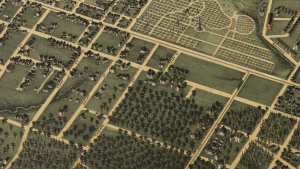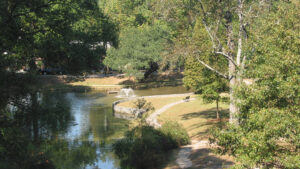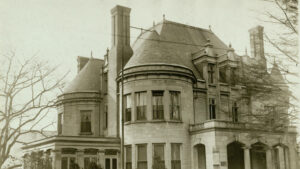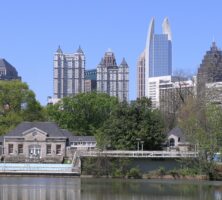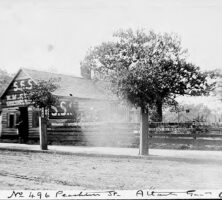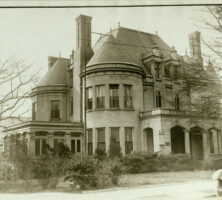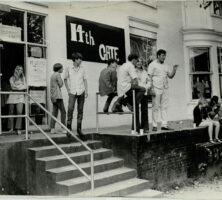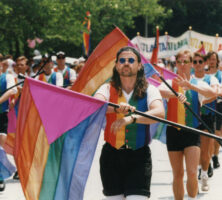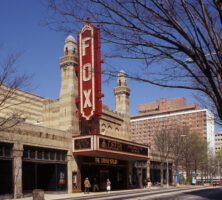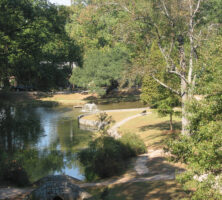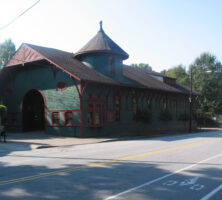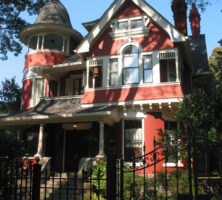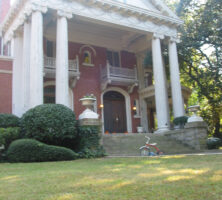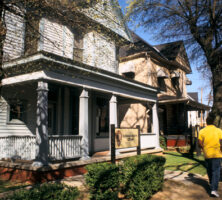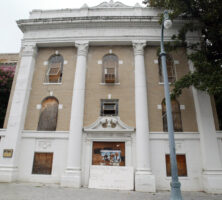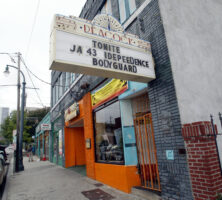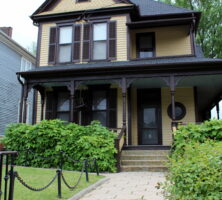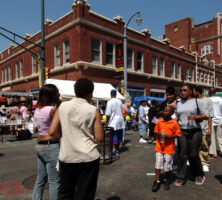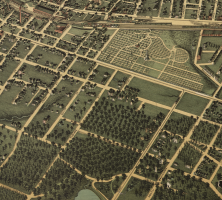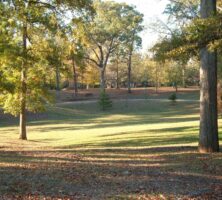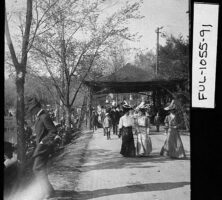The New Georgia Encyclopedia is supported by funding from A More Perfect Union, a special initiative of the National Endowment for the Humanities.
The Midtown skyline, seen here from Piedmont Park, reflects the neighborhood's dramatic growth. Midtown is the second-largest business district in Atlanta.
Photograph by Daniel Mayer
The New Georgia Encyclopedia does not hold the copyright for this media resource and can neither grant nor deny permission to republish or reproduce the image online or in print. All requests for permission to publish or reproduce the resource must be submitted to the rights holder.
Sections of Peachtree Street, Atlanta's primary thoroughfare, retained a rural character well into the late nineteenth century.
The New Georgia Encyclopedia does not hold the copyright for this media resource and can neither grant nor deny permission to republish or reproduce the image online or in print. Requests for permission to publish or reproduce the resource should be submitted to Special Collections and Archives at Georgia State University.
The Wimbish House is one of the last grand homes remaining on Peachtree Street. It was built in 1898 and designed by noted Atlanta architect W.T. Downing.
The New Georgia Encyclopedia does not hold the copyright for this media resource and can neither grant nor deny permission to republish or reproduce the image online or in print. Requests for permission to publish or reproduce the resource should be submitted to Special Collections and Archives at Georgia State University.
In the late 1960s and 1970s, Midtown became a haven for Atlanta's counterculture. Here, young residents of the neighborhood can be seen lounging at a local hangout in 1968.
The New Georgia Encyclopedia does not hold the copyright for this media resource and can neither grant nor deny permission to republish or reproduce the image online or in print. Requests for permission to publish or reproduce the resource should be submitted to Special Collections and Archives at Georgia State University.
Members of the Southern Element Flag Corps march down Peachtree Street in 1994 during the city's annual gay pride parade. A chapter of the Gay Liberation Front opened in Atlanta in 1971 and organized the city's first pride parade from 7th Street to Piedmont Park.
Courtesy of Atlanta Journal-Constitution.
The New Georgia Encyclopedia does not hold the copyright for this media resource and can neither grant nor deny permission to republish or reproduce the image online or in print. All requests for permission to publish or reproduce the resource must be submitted to the Atlanta Journal-Constitution.
Atlanta's Fox Theatre has seen more than $20 million in restoration projects since coming under the ownership of the nonprofit organization, Atlanta Landmarks, in 1975. The Fox was designated a National Historic Landmark in 1976.
The New Georgia Encyclopedia does not hold the copyright for this media resource and can neither grant nor deny permission to republish or reproduce the image online or in print. Requests for permission to publish or reproduce the resource may need to be submitted to the Georgia Department of Community Affairs, Historic Preservation Division.
Comprising ten acres, Springvale Park is the centerpiece of the Inman Park neighborhood, which was established in the late 1880s. In 1903 Inman Park founder Joel Hurt hired landscape architect Frederick Law Olmsted to improve the park aesthetically.
Photograph by Ted Bazemore
The New Georgia Encyclopedia does not hold the copyright for this media resource and can neither grant nor deny permission to republish or reproduce the image online or in print. All requests for permission to publish or reproduce the resource must be submitted to the rights holder.
Atlanta's first planned garden suburb, Inman Park was envisioned as an oasis for the city's wealthy citizens. After a period of decline, the neighborhood underwent an extensive restoration, beginning in the 1970s.
Photograph by Ted Bazemore
The New Georgia Encyclopedia does not hold the copyright for this media resource and can neither grant nor deny permission to republish or reproduce the image online or in print. All requests for permission to publish or reproduce the resource must be submitted to the rights holder.
The Trolley Barn in Inman Park was the terminus for Atlanta's first electric streetcar line, which ran west to downtown. The barn was the repair depot for the streetcars. Today the building is used for community events.
Photograph by Ted Bazemore
The New Georgia Encyclopedia does not hold the copyright for this media resource and can neither grant nor deny permission to republish or reproduce the image online or in print. All requests for permission to publish or reproduce the resource must be submitted to the rights holder.
In 1969 Robert Griggs purchased and restored this Queen Anne-style house on Euclid Avenue, thereby launching the Inman Park restoration movement.
Photograph by Ted Bazemore
The New Georgia Encyclopedia does not hold the copyright for this media resource and can neither grant nor deny permission to republish or reproduce the image online or in print. All requests for permission to publish or reproduce the resource must be submitted to the rights holder.
The Beaux-Arts style Callan Castle (1902-4) was built in Inman Park for Coca-Cola Company founder Asa Candler.
Photograph by Ted Bazemore
The New Georgia Encyclopedia does not hold the copyright for this media resource and can neither grant nor deny permission to republish or reproduce the image online or in print. All requests for permission to publish or reproduce the resource must be submitted to the rights holder.
The Sweet Auburn neighborhood was the heart of the Black residential and business community in the first part of the twentieth century. Pictured in the foreground is an administrative office of the National Park Service, which maintains the Martin Luther King Jr. National Historic Site in the neighborhood.
Courtesy of Georgia Department of Economic Development.
The New Georgia Encyclopedia does not hold the copyright for this media resource and can neither grant nor deny permission to republish or reproduce the image online or in print. Requests for permission to publish or reproduce the resource may need to be submitted to the Georgia Department of Economic Development.
The old Atlanta Life Insurance building, pictured in 2005, is boarded up on Auburn Avenue. Established by Alonzo Herndon in 1905, Atlanta Life was one of three financial institutions, all headquartered in the Sweet Auburn district, that served the Black middle class in Atlanta before the civil rights movement.
Courtesy of Atlanta Journal-Constitution.
The New Georgia Encyclopedia does not hold the copyright for this media resource and can neither grant nor deny permission to republish or reproduce the image online or in print. All requests for permission to publish or reproduce the resource must be submitted to the Atlanta Journal-Constitution.
The Royal Peacock, a club located in Atlanta's Sweet Auburn historic district, was formerly known as the Top Hat Club, one of the city's premier African American music venues early in the twentieth century.
Courtesy of Atlanta Journal-Constitution.
The New Georgia Encyclopedia does not hold the copyright for this media resource and can neither grant nor deny permission to republish or reproduce the image online or in print. All requests for permission to publish or reproduce the resource must be submitted to the Atlanta Journal-Constitution.
The birthplace of Martin Luther King Jr. in Atlanta is one of the many historic properties that J. W. Robinson has worked to restore.
Image from Wally Gobetz
The New Georgia Encyclopedia does not hold the copyright for this media resource and can neither grant nor deny permission to republish or reproduce the image online or in print. All requests for permission to publish or reproduce the resource must be submitted to the rights holder.
Visitors enjoy the activities offered at the Sweet Auburn Heritage Festival, held each year in the Auburn Avenue historic district. The festival was founded in 1984 by civil rights leader Hosea Williams.
Courtesy of Atlanta Journal-Constitution.
The New Georgia Encyclopedia does not hold the copyright for this media resource and can neither grant nor deny permission to republish or reproduce the image online or in print. All requests for permission to publish or reproduce the resource must be submitted to the Atlanta Journal-Constitution.
Bird's-eye view of Grant Park and Oakland Cemetery in 1892, drawn by Augustus Koch.
Courtesy of Library of Congress
The New Georgia Encyclopedia does not hold the copyright for this media resource and can neither grant nor deny permission to republish or reproduce the image online or in print. All requests for permission to publish or reproduce the resource must be submitted to the rights holder.
Grant Park is now the oldest surviving park in Atlanta and houses Zoo Atlanta and a residential area. The park was named after Lemuel P. Grant, who donated the land to Atlanta in 1881.
Image from Scott Ehardt
The New Georgia Encyclopedia does not hold the copyright for this media resource and can neither grant nor deny permission to republish or reproduce the image online or in print. All requests for permission to publish or reproduce the resource must be submitted to the rights holder.
In 1999 giant pandas arrived at Zoo Atlanta, located in the city's historic Grant Park, and quickly became one of the most popular attractions at the facility. Each year more than 500,000 people visit the zoo, which focuses on education, conservation, and research.
Courtesy of Georgia Department of Economic Development.
The New Georgia Encyclopedia does not hold the copyright for this media resource and can neither grant nor deny permission to republish or reproduce the image online or in print. Requests for permission to publish or reproduce the resource may need to be submitted to the Georgia Department of Economic Development.
The lake at Grant Park, ca. 1907. The boathouse can be seen in the background.
Courtesy of Georgia Archives, Vanishing Georgia, #
ful0415.
The New Georgia Encyclopedia does not hold the copyright for this media resource and can neither grant nor deny permission to republish or reproduce the image online or in print. Requests for permission to publish or reproduce the resource should be submitted to the Georgia Archives.
Atlanta residents stroll through Grant Park in 1907. Other popular activities at the park included swimming, boating, and playing tennis.
Courtesy of Georgia Archives, Vanishing Georgia, #
ful1055-91.
The New Georgia Encyclopedia does not hold the copyright for this media resource and can neither grant nor deny permission to republish or reproduce the image online or in print. Requests for permission to publish or reproduce the resource should be submitted to the Georgia Archives.

